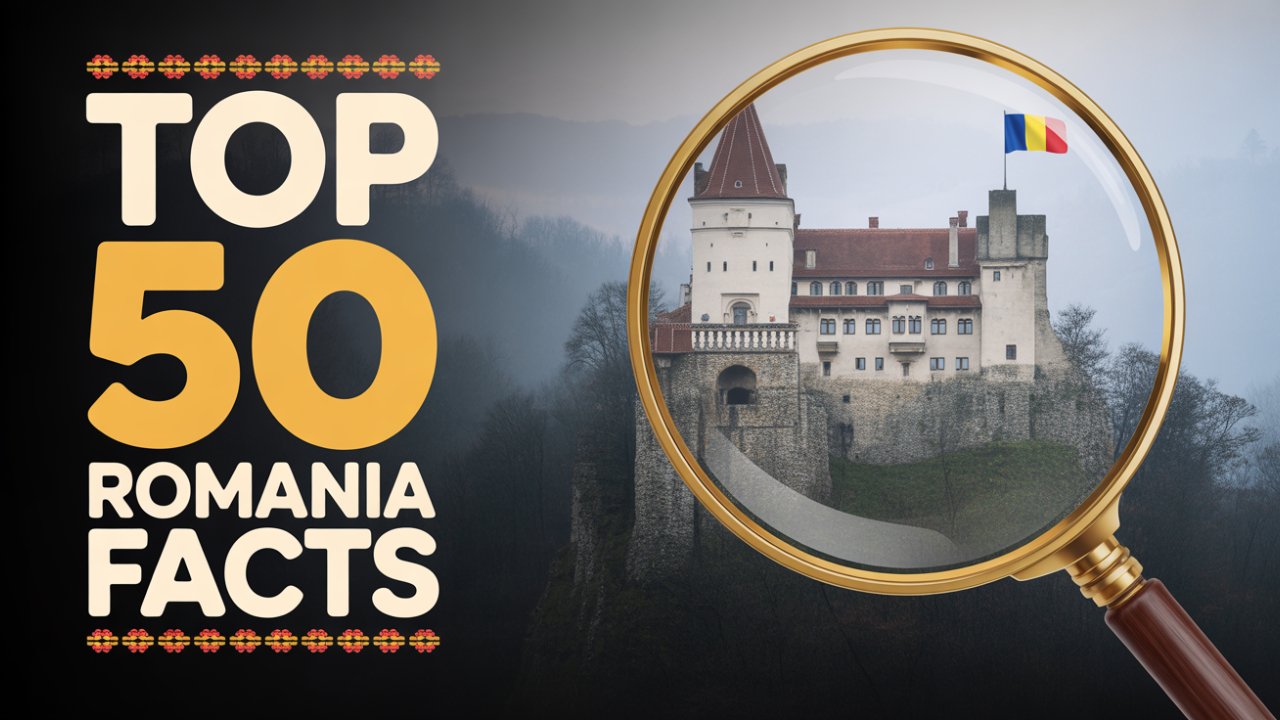When you think of Romania, you probably think of this… and maybe a certain vampire.
But what if I told you that’s like judging an entire library by its cover? From the heaviest building on the planet to the invention of the fountain pen, Romania is hiding a treasure trove of secrets.
So, get ready. We’re about to count down the Top 50 Surprising Facts About Romania You Won’t Believe and completely transform how you see this incredible country.Number 1: Let’s start with the name itself. The name “Romania” literally means “Citizen of Rome,” coming directly from the Latin word “Romanus.” This is a direct echo of the region’s history after the Roman Empire conquered it in the 2nd century AD. That conquest left a permanent, Latin-based mark on the people and their language, making Romania a unique Latin island in a sea of Slavic neighbors.
Number 2: But the history here is ancient, stretching back long before the Romans ever arrived. The land that is now Romania was a cradle for one of Europe’s earliest and most advanced civilizations. The Cucuteni-Trypillia culture, which flourished from around 5500 to 2750 BC, was incredibly sophisticated for its time. They weren’t just building simple villages; they constructed massive settlements, some with up to three thousand structures that may have housed tens of thousands of people, making them among the largest on Earth at the time. They also created stunningly intricate pottery that remains a marvel of prehistoric art.
Number 3: The human story in Romania goes back even further. In a cave system in the country’s southwest, called Peștera cu Oase or “The Cave with Bones,” researchers discovered some of the oldest modern human remains ever found in Europe. These fossils, dated to be between 37,000 and 42,000 years old, belong to the first wave of Homo sapiens to enter the continent. And get this: genetic analysis showed they had a surprisingly recent Neanderthal ancestor, providing direct evidence that early humans and Neanderthals were interbreeding in Europe.
Number 4: Romania isn’t just home to Europe’s oldest human fossils, but also to some of its oldest art. Deep inside Coliboaia Cave, explorers found charcoal drawings that are estimated to be around 32,000 years old. These ancient sketches, which depict animals like bison and rhinos, are some of the oldest examples of cave art in Central and Eastern Europe. It just goes to show that the creative spirit has lived in these lands for tens of thousands of years.
Number 5: Speaking of ancient records, clay tablets discovered in Tărtăria have sparked a massive historical debate. Some researchers believe they contain the world’s oldest known form of writing, dating back to around 5300 BC. If that’s true, it would mean that writing was developed here long before the cuneiform of Mesopotamia or the hieroglyphs of ancient Egypt, completely rewriting the timeline of human communication. The debate rages on, but the possibility is staggering.
Number 6: Let’s dig into another world first. Romania is home to what is believed to be the oldest salt mine in the world. At a site called Poiana Slatinei, archaeological evidence shows that salt was being extracted as far back as 6050 BC. This ancient industry was fundamental for the development of prehistoric societies, since salt was a crucial commodity for preserving food and for trade.
Number 7: While Bram Stoker’s Dracula made Transylvania world-famous, the region’s real history is just as compelling, thanks to the Transylvanian Saxons. Invited by the Hungarian King in the 12th century, these German craftsmen and merchants built incredible fortified towns and churches to defend the frontier. Today, UNESCO recognizes seven of these villages with their fortified churches as a World Heritage Site, preserving a unique cultural landscape where medieval Germany stands strong in the heart of Romania.
Number 8: Romania has a language unlike any of its neighbors. It is the only country in Eastern Europe where a Romance language is spoken. Romanian is a direct descendant of the Latin spoken by Roman soldiers and colonists who settled the province of Dacia. Even though it’s surrounded by Slavic-speaking countries like Bulgaria, Serbia, and Ukraine, the language has held on to its Latin core, making it a fascinating linguistic outlier.
Number 9: Prepare for a truly unusual and poignant destination: The Merry Cemetery of Săpânța. This is a cemetery that flips the script on death and mourning. Instead of somber, grey tombstones, this graveyard is filled with over 800 vibrant, hand-painted wooden crosses. Each cross features a colorful painting and a witty poem that candidly tells the life story of the person buried there sometimes even revealing their secret vices. Some say this unique outlook is inspired by the ancient Dacians, who are said to have believed death was a joyful passage to a better life.
Number 10: In that same village of Săpânța, another record-breaking structure stands tall. The Săpânța-Peri Monastery is home to the tallest wooden church in the world. Its spire reaches a staggering height of 77 meters, or 253 feet, and seems to pierce the sky. This incredible feat of traditional wooden architecture is a powerful symbol of the faith and craftsmanship of the Maramureș region.
Number 11: The city of Timișoara was way ahead of its time. In 1884, it became the very first city in mainland Europe to have electric street lighting. Imagine the scene: while major capitals like Paris and Berlin were still lit by gas lamps, the streets of this Romanian city were blazing with the glow of 731 electric lamps. This pioneering spirit really set Timișoara apart as a forward-thinking hub.
Number 12: Long before the oil sheikdoms of the Middle East dominated the energy market, Romania was a true pioneer. The country has a long history of oil production, with the world’s first industrial oil refinery being built in Ploiești in 1856. A year later, in 1857, Bucharest became the first city in the world to be publicly lit using kerosene, and that same year, Romania was officially recorded as the first country in the world with commercial oil production.
Number 13: Forget baseball for a moment and meet its older Romanian cousin, Oina. This traditional sport, which has been played in Romania for centuries, looks a lot like baseball but actually predates it. First documented way back in the 14th century, Oina is a complex bat-and-ball game played between two teams of 11. It’s so integral to the nation’s heritage that it was officially recognized as Romania’s national sport.
Number 14: If you’ve ever enjoyed a perfect cup of espresso, you might have a Romanian to thank. Francesco Illy, the founder of the world-renowned Illycaffè, was born in Timișoara. He later moved to Italy where, in 1933, he invented the “Illetta,” the first automatic espresso machine that used compressed air instead of steam. This innovation produced a smoother, less bitter coffee and is the direct ancestor of the modern espresso machines we use today.
Number 15: The Romanian Revolution in December 1989 was a moment that changed everything, ending 42 years of brutal communist rule. It was the last and only violent revolution to topple a government in a Warsaw Pact country during the revolutions of 1989. The uprising started in Timișoara and quickly spread to Bucharest, culminating in the trial and execution of the dictator Nicolae Ceaușescu and his wife on Christmas Day, an event broadcast on live television.
Number 16: Deep beneath the surface near the Black Sea coast lies a place that feels like another planet. Movile Cave was sealed off from the outside world for an estimated 5.5 million years, only to be discovered by accident in 1986. Inside, the atmosphere is toxic and has very little oxygen. And yet, it’s teeming with life. This unique ecosystem runs entirely on chemosynthesis, not sunlight. Scientists have found over 50 species here, 37 of which are found nowhere else on Earth, including eyeless spiders and translucent leeches.
Number 17: While the United States has the Pentagon, Romania has the Palace of the Parliament. Located in Bucharest, this colossal building is the second-largest administrative building in the world by surface area. But even more impressively, it is officially the heaviest building on the entire planet. Built during the Ceaușescu regime, it contains an astounding 700,000 tonnes of steel and bronze, a million cubic meters of marble, and 3,500 tonnes of crystal. Its scale is so massive, it’s hard to even wrap your head around.
Number 18: Tucked away in the Carpathian Mountains is Peleș Castle, a masterpiece of German neo-Renaissance architecture. But it wasn’t just beautiful, it was shockingly modern. When it was built between 1873 and 1914, Peleș was the first castle in Europe to be fully powered by electricity from its very own power plant. It also featured central heating, a central vacuuming system, an internal elevator, and even a stained-glass ceiling that could open to the sky.
Number 19: The Transfăgărășan highway is not just a road; it’s an epic journey. Winding and twisting through the Carpathian Mountains, this military road was built in the 1970s. It climbs to an altitude of over 2,000 meters, or 6,700 feet, and is famous for its hairpin turns and sharp descents. It’s so spectacular that in 2009, the British TV show Top Gear famously declared it “the best road in the world,” drawing driving enthusiasts from all over the globe.
Number 20: Romania’s natural wonders extend far below the ground. Hiding in the Apuseni Mountains is the Scărișoara Ice Cave, which houses the second-largest underground glacier in Europe. The massive block of ice has a volume of 75,000 cubic meters and is estimated to be over 3,500 years old. Descending into the cave is like stepping into a frozen, subterranean cathedral, with magnificent ice stalagmites creating an otherworldly spectacle.
Number 21: The Danube River, Europe’s second-longest, ends its journey in Romania by forming one of the world’s most spectacular wetlands. The Danube Delta is the largest and best-preserved river delta in Europe, a UNESCO World Heritage site, and an absolute paradise for wildlife. This vast labyrinth of water, reeds, and islands is home to over 300 species of birds and 45 species of freshwater fish, making it a biodiversity hotspot of global importance.
Number 22: The Carpathian Mountains, which arc across the country, are one of Europe’s last great wilderness areas. They are home to the continent’s largest populations of brown bears, wolves, and lynx outside of Russia. In fact, over 5,000 brown bears roam these forests, making it one of the best places in Europe to see these magnificent creatures in their natural habitat.
Number 23: You might not expect it, but Romania has some of the fastest internet speeds in the world, consistently ranking high in global surveys for fixed broadband. This is because the country’s rapid development in the post-communist era allowed it to leapfrog older copper wire infrastructure and invest heavily in modern fiber-optic technology. The result is that many Romanians enjoy blazing-fast internet that’s the envy of much of the world.
Number 24: For a truly surreal experience, you can visit the Berca Mud Volcanoes. This isn’t a typical volcano with lava and ash. Instead, it’s a rare geological phenomenon where gas from deep within the earth pushes cold, muddy water to the surface. This process has created a bizarre, lunar-like landscape of bubbling grey craters that makes you feel as though you’ve stepped onto another planet.
Number 25: Romania’s capital, Bucharest, earned the nickname “Little Paris” in the early 20th century, and for good reason. During its golden age between the two World Wars, the city embraced elegant French-inspired architecture. Grand boulevards were carved through the city, and a triumphal arch, the Arcul de Triumf, was built, modeled directly on its famous Parisian counterpart. Though much has changed, you can still find glimpses of this glamorous past.
Number 26: At the 1976 Montreal Olympics, a 14-year-old Romanian gymnast named Nadia Comăneci did something that was considered impossible: she scored a perfect 10. The scoreboards weren’t even programmed to display a 10.0, so they showed a 1.00 instead, creating a moment of mass confusion before the historic achievement was understood. Nadia went on to earn six more perfect 10s at those games, becoming a global icon and changing gymnastics forever.
Number 27: Romania has a rich intellectual tradition that has produced four Nobel Prize winners a remarkable achievement for a country of its size. George Emil Palade won for his work in cell biology, Elie Wiesel was awarded the Nobel Peace Prize, Herta Müller received the Nobel Prize in Literature for her powerful depictions of life under dictatorship, and Stefan Hell won the Nobel Prize in Chemistry for his work in super-resolved microscopy.
Number 28: The city of Sighișoara is a real-life fairy tale. Its historic center is one of the best-preserved inhabited medieval citadels in Europe and is a designated UNESCO World Heritage site. Walking through its cobblestone streets, past colorful houses and ancient towers, is like stepping back into the 15th century. It’s also famously the birthplace of Vlad the Impaler, the historical figure who inspired the Dracula legend.
Number 29: Here’s a surprising connection: His Majesty King Charles III has deep ancestral links to Transylvania, tracing his lineage all the way back to Vlad the Impaler. He has spoken fondly of his love for Romania, even describing it as “in my blood.” He owns several properties in rural Transylvania and has been a passionate advocate for preserving the region’s unique cultural heritage and sustainable farming.
Number 30: Romania’s railway network is one of the most extensive in Europe. With nearly 11,000 kilometers of railway lines, the network remains a vital part of the country’s transportation infrastructure, connecting major cities and remote villages alike. Traveling by train offers a classic and scenic way to experience Romania’s diverse landscapes.
Number 31: The modern fountain pen, an essential tool for writers for over a century, was invented by a Romanian. Petrache Poenaru, a student in Paris, received a patent in 1827 for a pen that used a swan’s quill as an ink reservoir. His invention was designed to save time and stop the mess of traditional dip pens, laying the groundwork for the fountain pens we know today.
Number 32: The formation of modern Romania was born from a brilliant political maneuver. In 1859, the principalities of Moldavia and Wallachia decided to unite. The great powers of Europe agreed, but insisted they have separate rulers. The Romanians found a loophole. In the elections, they voted for the exact same man, Alexandru Ioan Cuza, to be the prince of both principalities. Faced with this clever move, the European powers eventually had to accept it, and the modern state of Romania was born.
Number 33: The Romanian language contains a word that is notoriously difficult to translate: “dor.” It’s a small word with a vast meaning, describing a deep, melancholic longing or yearning for someone or something that is absent or lost. It’s a bittersweet blend of nostalgia, sadness, love, and desire all wrapped into one, capturing a complex emotional state deeply ingrained in Romanian culture.
Number 34: While Dracula gets all the attention, Romania’s folklore is rich with other fascinating mythical creatures. One of the most prominent is the “strigoi,” troubled spirits said to rise from the grave, more like ghouls than aristocratic vampires. The folklore also includes beings like the “Iele,” beautiful supernatural women who dance in the forests, and the “Pricolici,” a type of werewolf or vampire that takes the form of a wolf.
Number 35: The Wooden Churches of Maramureș are another of Romania’s UNESCO treasures. This collection of eight churches represents a pinnacle of wooden architecture. Built from thick logs, they’re characterized by their tall, slender clock towers and shingled roofs, blending Orthodox traditions with Gothic influences to create a style that is uniquely Romanian.
Number 36: Romania is a country of vibrant and unique festivals. One of the most spectacular is the annual Bear Dance, or “Ursul,” a pre-Christian ritual performed between Christmas and New Year. People of all ages dress in real bearskins and dance through the streets to the sound of drums. This ancient ceremony symbolizes the death and rebirth of the year, with the bear believed to ward off evil spirits.
Number 37: The Painted Monasteries of Bucovina are like storybooks painted on the walls of churches. These 15th and 16th-century monasteries are famous for their exterior frescoes, which depict intricate biblical scenes in stunning detail. The whole point of these massive paintings was to make the stories of the Bible accessible to the illiterate villagers of the time. The vibrant colors, especially a unique shade known as “Voroneț blue,” have miraculously survived centuries of weather.
Number 38: In the world of music, George Enescu stands as Romania’s most revered composer. A child prodigy, he became a celebrated violinist, conductor, and teacher. His most famous works are the “Romanian Rhapsodies,” which brilliantly weave the melodies and rhythms of Romanian folk music into classical compositions, bringing the country’s musical traditions to the international stage.
Number 39: Romania was the birthplace of one of the 20th century’s most influential artistic movements: the Theater of the Absurd. Playwright Eugène Ionesco, born in Romania, was a leading pioneer of this form. His plays, like “The Bald Soprano,” used illogical situations and nonsensical dialogue to explore themes of existentialism, fundamentally changing the landscape of modern drama.
Number 40: Alongside Ionesco, Romania produced a group of brilliant but often pessimistic thinkers who made their mark on world philosophy. Emil Cioran, another Romanian-born philosopher, became famous for his works of philosophical pessimism and nihilism. Together with figures like Ionesco and the historian Mircea Eliade, he was part of a remarkable generation of Romanian intellectuals who took Paris by storm.
Number 41: The Bigăr Waterfall was once celebrated as one of the most unique waterfalls in the world, thanks to a viral photo gallery in 2013. Its fame came from its unusual shape, where water fanned out over a large, bell-shaped rock covered in green moss. Although the main rock formation collapsed in 2021 due to natural causes, the area remains a beautiful testament to the power and artistry of nature.
Number 42: Romania’s flag tells a story of revolution. The tricolor of blue, yellow, and red represents the three historic provinces: Transylvania, Wallachia, and Moldavia. During the communist era, a socialist coat of arms was placed in the center. At the height of the 1989 revolution, protesters began physically cutting the emblem out of the flag. This “flag with the hole” became a powerful and iconic symbol of rejecting communist rule.
Number 43: The country has a shocking number of caves over 12,000 have been cataloged. This vast subterranean world is a result of the country’s karst-rich landscape, especially in the Apuseni Mountains. These caves range from tiny fissures to vast underground systems, and beyond the famous ones, this network offers endless opportunities for exploration, with many secrets still waiting to be uncovered.
Number 44: Romania is a land of remarkable biodiversity, housing an incredible 30% of all plant species found in Europe. The country’s diverse geography, from the Carpathian Mountains to the Danube Delta, creates a wide range of habitats. This includes many rare and endemic species, like the edelweiss and various orchids, making Romania a botanist’s dream.
Number 45: The country plays a huge role in European conservation. It is home to one of the largest areas of untouched, virgin forests in Europe outside of Russia. Most of these pristine forests are in the Carpathian Mountains, with the Southern Carpathians making up Europe’s largest unfragmented forest area. These ancient woodlands are vital ecosystems, acting as the green lungs of the continent.
Number 46: One of Bucharest’s coolest hidden gems is its “passage” culture. Tucked between buildings in the old city center are several beautiful, covered passageways. The most famous is the Macca-Vilacrosse Passage, a fork-shaped, yellow glass-covered arcade built in 1891. Lined with cafes, exploring them feels like discovering a secret, more intimate side of the bustling capital.
Number 47: The Romanian Athenaeum in Bucharest is more than just a concert hall; it’s a national symbol of resilience. Opened in 1888, the building was financed almost entirely by the public in a campaign called “Give a penny for the Athenaeum.” Inside, a massive fresco circles the concert hall, depicting scenes from Romanian history. It’s a magnificent monument to the country’s artistic spirit.
Number 48: The Dacian Fortresses of the Orăștie Mountains are another of Romania’s powerful UNESCO World Heritage sites. Dating to the 1st centuries BC and AD, these six fortresses were the heart of the Dacian Kingdom. They represent the last line of defense against the might of the Roman Empire and are a poignant reminder of a proud, ancient culture that was ultimately conquered.
Number 49: Romania’s multicultural heritage is one of its greatest strengths. For centuries, it has been home to large communities of Hungarians, Germans, and Roma people, as well as smaller groups of Serbs, Ukrainians, and Turks. This rich ethnic and cultural mosaic is reflected in the country’s traditions, food, and architecture, creating a dynamic and layered society where different cultures have influenced one another for generations.
Number 50: And finally, a fact that speaks volumes about the Romanian spirit: resilience. Throughout its long history, Romania has been a battleground for empires the Romans, the Ottomans, the Austro-Hungarians, and the Russians. The 20th century brought two World Wars and decades of a harsh communist dictatorship. Yet, through it all, the Romanian people have held on to their unique Latin culture and identity. The emergence of a vibrant, modern nation in the heart of Eastern Europe is perhaps the most surprising and inspiring fact of all.
And there you have it 50 facts that prove Romania is so much more than the myths. It’s a nation of ancient civilizations, stunning natural beauty, world-changing inventions, and an unbreakable spirit.
What was your favorite fact? Or did we miss one you think is even more surprising? Let us know in the comments below. If you enjoyed this journey, give this video a ‘like’ and be sure to subscribe and hit that notification bell so you don’t miss our next deep dive.
Thanks for watching. Until next time, keep exploring.





